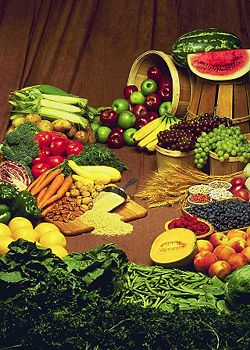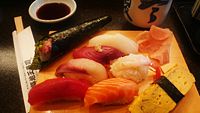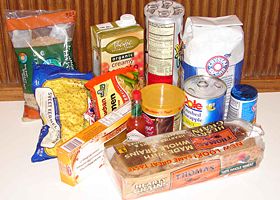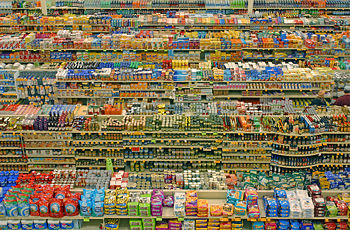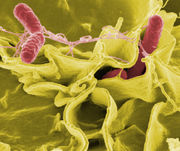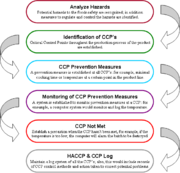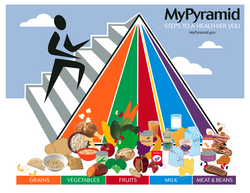Food
2008/9 Schools Wikipedia Selection. Related subjects: Everyday life; Food
Food is any substance, usually composed primarily of carbohydrates, fats, water and/or proteins, that can be eaten or drunk by an animal for nutrition or pleasure. Items considered food may be sourced from plants, animals or other categories such as fungus or fermented products like alcohol. Although many human cultures sought food items through hunting and gathering, today most cultures use farming, ranching, and fishing, with hunting, foraging and other methods of a local nature included but playing a minor role.
Most traditions have a recognizable cuisine, a specific set of cooking traditions, preferences, and practices, the study of which is known as gastronomy. Many cultures have diversified their foods by means of preparation, cooking methods and manufacturing. This also includes a complex food trade which helps the cultures to economically survive by-way-of food, not just by consumption.
Many cultures study the dietary analysis of food habits. While humans are omnivores, religion and social constructs such as morality often affect which foods they will consume. Food safety is also a concern with foodborne illness claiming many lives each year. In many languages, food is often used metaphorically or figuratively, as in "food for thought".
Production

Food is traditionally obtained through farming, ranching, and fishing, with hunting, foraging and other methods of subsistence locally important. More recently, there has been a growing trend towards more sustainable agricultural practices. This approach, which is partly fueled by consumer demand, encourages biodiversity, local self-reliance and organic farming methods. Major influences on food production are international organizations, (e.g. the World Trade Organization and Common Agricultural Policy), national government policy (or law), and war.
Preparation
While some food can be eaten raw, many foods undergo some form of preparation for reasons of safety, palatability, or flavor. At the simplest level this may involve washing, cutting, trimming or adding other foods or ingredients, such as spices. It may also involve mixing, heating or cooling, pressure cooking, fermentation, or combination with other food. In a home, most food preparation takes place in a kitchen. Some preparation is done to enhance the taste or aesthetic appeal; other preparation may help to preserve the food; and others may be involved in cultural identity. A meal is made up of food which is prepared to be eaten at a specific time and place.
Animal slaughter and butchering
The preparation of animal-based food will usually involve slaughter, evisceration, hanging, portioning and rendering. In developed countries, this is usually done outside the home in slaughterhouses which are used to process animals en mass for meat production. Many countries regulate their slaughterhouses by law. For example the United States has established the Humane Slaughter Act of 1958, which requires that an animal be stunned before killing. This act, like those in many countries, exempts slaughter in accordance to religious law, such as kosher shechita and dhabiĥa halal. Strict interpretations of kashrut require the animal to be fully aware when its carotid artery is cut.
On the local level a butcher may commonly break down larger animal meat into smaller manageable cuts and pre-wrapped for commercial sale or wrapped to order in butcher paper. In addition fish and seafood may be fabricated into smaller cuts by a fish monger at the local level. However fish butchery may be done on board a fishing vessel and quick-frozen for preservation of quality.
Cooking
The term "cooking" encompasses a vast range of methods, tools and combinations of ingredients to improve the flavor or digestibility of food. Cooking technique, known as culinary art, generally requires the selection, measurement and combining of ingredients in an ordered procedure in an effort to achieve the desired result. Constraints on success include the variability of ingredients, ambient conditions, tools, and the skill of the individual cooking. The diversity of cooking worldwide is a reflection of the myriad nutritional, aesthetic, agricultural, economic, cultural and religious considerations that impact upon it.
Cooking requires applying heat to a food which usually, though not always, chemically transforms it, thus changing its flavor, texture, appearance, and nutritional properties. Cooking proper, as opposed to roasting, requires the boiling of water in a container, and was practiced at least since the 10th millennium BC with the introduction of pottery. There is archaeological evidence of roasted foodstuffs at Homo erectus campsites dating from 420,000 years ago.
Cooking equipment and methods
There are many types of cooking equipment used for cooking. Ovens are one type of cooking equipment which can be used for baking or roasting and offer a dry-heat cooking method. Different cuisines will use different types of ovens, for example Indian culture uses a Tandoor oven is a cylindrical clay oven which operates at a single high temperature, while western kitchens will use variable temperature convection ovens, conventional ovens, toaster ovens in addition to non-radiant heat ovens like the microwave oven. Ovens may be wood-fired, coal-fired, gas, electric, or oil-fired.
Various types of cook-tops are used as well. They carry the same variations of fuel types as the ovens mentioned above. cook-tops are used to heat vessels placed on top of the heat source, such as a sauté pan, sauce pot, frying pan, pressure cooker, etc. These pieces of equipment can use either a moist or dry cooking method and include methods such as steaming, simmering, boiling, and poaching for moist methods; while the dry methods include sautéing, pan frying, or deep-frying.
In addition, many cultures use grills for cooking. A grill operates with a radiant heat source from below, usually covered with a metal grid and sometimes a cover. An open bit barbecue in the American south is one example along with the American style outdoor grill fueled by wood, liquid propane or charcoal along with soaked wood chips for smoking. A Mexican style of barbecue is called barbacoa, which involves the cooking of meats and whole sheep over open fire. In Argentina, asado is prepared on a grill held over an open pit or fire made upon the ground, on which a whole animal is grilled or in other cases smaller cuts of the animal.
Raw food
Certain cultures highlight animal and vegetable foods in their raw state. Sushi in Japan is one such cuisine that features raw sliced fish, either in sashimi, nigiri, or maki styles. Steak tartare and salmon tartare are dishes made from diced or ground raw beef or salmon respectively, mixed with various ingredients and served with baguette, brioche or frites. In Italy, carpaccio is a dish of very thin sliced raw beef, drizzled with a vinaigrette made with olive oil. A popular health food movement known as raw foodism promotes a mostly vegan diet of raw fruits, vegetables and grains prepared in various ways, including juicing, food dehydration, not passing the 118 degree mark, and sprouting.
Restaurants
Many cultures produce food for sale in restaurants for paying customers. These restaurants often have trained chefs who prepare the food, while trained waitstaff serve the customers. The term restaurant is credited to the French from the 19th century, as it relates to the restorative nature of the bullions that were once served in them. However, the concept pre-dates the naming of these establishments, as evidence suggests commercial food preparation may have existed during the age of the city of Pompeii, as well as an urban sales of prepared foods in China during the Song Dynasty. The coffee shops or cafes of 17th century Europe may also be considered an early version of the restaurant. In 2005 the United States spent $496 billion annually for out-of-home dining. Expenditures by type of out-of-home dining was as follows, 40% in full-service restaurants, 37.2% in limited service restaurants ( fast food), 4.7% in hotels and motels, 6.6% in schools or colleges, 5.4% in bars and vending machines, 4.0% in recreational places, and 2.2% in other which includes military bases.
Food manufacture
Packaged foods are manufactured outside the home for purchase. This can be as simple as a butcher preparing meat, or as complex as a modern international food industry. Early food processing techniques were limited by available food preservation, packaging and transportation. This mainly involved salting, curing, curdling, drying, pickling, fermentation and smoking. During the industrialization era in the 19th century, food manufacturing arose. This development took advantage of new mass markets and emerging new technology, such as milling, preservation, packaging and labeling and transportation. It brought the advantages of pre-prepared time saving food to the bulk of ordinary people who did not employ domestic servants.
At the start of the 21st century, a two-tier structure has arisen, with a few international food processing giants controlling a wide range of well-known food brands. There also exists a wide array of small local or national food processing companies. Advanced technologies have also come to change food manufacture. Computer-based control systems, sophisticated processing and packaging methods, and logistics and distribution advances, can enhance product quality, improve food safety, and reduce costs.
Commercial trade
International exports and imports
World Bank reported that the EU was the top food importer in 2005 followed at a distance by the USA and Japan. Food is now traded and marketed on a global basis. The variety and availability of food is no longer restricted by the diversity of locally grown food or the limitations of the local growing season. Between 1961 and 1999 there has been a 400% increase in worldwide food exports. Some countries are now economically dependent on food exports, which in some cases account for over 80% of all exports.
In 1994 over 100 countries became signatories to the Uruguay Round of the General Agreement on Tariffs and Trade in a dramatic increase in trade liberalization. This included an agreement to reduce subsidies paid to farmers, underpinned by the WTO enforcement of agricultural subsidy, tariffs, import quotas and settlement of trade disputes that cannot be bilaterally resolved. Where trade barriers are raised on the disputed grounds of public health and safety, the WTO refer the dispute to the Codex Alimentarius Commission, which was founded in 1962 by the United Nations Food and Agriculture Organization and the World Health Organization. Trade liberalization has greatly affected world food trade.
Marketing and retailing
Food marketing brings together the producer and the consumer. It is the chain of activities that brings food from "farm gate to plate." The marketing of even a single food product can be a complicated process involving many producers and companies. For example, fifty-six companies are involved in making one can of chicken noodle soup. These businesses include not only chicken and vegetable processors but also the companies that transport the ingredients and those who print labels and manufacture cans. The food marketing system is the largest direct and indirect non-government employer in the United States.
In the pre-modern era, the sale of surplus food took place once a week when farmers took their wares on market day, into the local village market place. Here food was sold to grocers for sale in their local shops for purchase by local consumers. With the onset of industrialization, and the development of the food processing industry, a wider range of food could be sold and distributed in distant locations. Typically early grocery shops would be counter-based shops, in which purchasers told the shop-keeper what they wanted, so that the shop-keeper could get it for them.
In the 20th century supermarkets were born. Supermarkets brought with them a self service approach to shopping using shopping carts, and were able to offer quality food at lower cost through economies of scale and reduced staffing costs. In the latter part of the 20th century, this has been further revolutionized by the development of vast warehouse-sized out-of-town supermarkets, selling a wide range of food from around the world.
Unlike food processors, food retailing is a two-tier market in which a small number of very large companies control a large proportion of supermarkets. The supermarket giants wield great purchasing power over farmers and processors, and strong influence over consumers. Nevertheless, less than ten percent of consumer spending on food goes to farmers, with larger percentages going to advertising, transportation, and intermediate corporations.
Famine and hunger
Food deprivation leads to malnutrition and ultimately starvation. This is often connected with famine, which involves the absence of food in entire communities. This can have a devastating and widespread effect on human health and mortality. Rationing is sometimes used to distribute food in times of shortage, most notably during times of war.
Starvation is a significant international problem. Approximately 815 million people are undernourished, and over 16,000 children die per day from hunger-related causes. Food deprivation is regarded as a deficit need in Maslow's hierarchy of needs and is measured using famine scales.
Food aid
Food aid can benefit people suffering from a shortage of food. It can be used to improve peoples' lives in the short term, so that a society can increase its standard of living to the point that food aid is no longer required. Conversely, badly managed food aid can create problems by disrupting local markets, depressing crop prices, and discouraging food production. Sometimes a cycle of food aid dependence can develop. Its provision, or threatened withdrawal, is sometimes used as a political tool to influence the policies of the destination country, a strategy known as food politics. Sometimes, food aid provisions will require certain types of food be purchased from certain sellers, and food aid can be misused to enhance the markets of donor countries. International efforts to distribute food to the neediest countries are often co-ordinated by the World Food Programme.
Safety
Foodborne illness, commonly called "food poisoning," is caused by bacteria, toxins, viruses, parasites, and prions. Roughly 7 million people die of food poisoning each year, with about 10 times as many suffering from a non-fatal version. The two most common factors leading to cases of bacterial foodborne illness are cross-contamination of ready-to-eat food from other uncooked foods and improper temperature control. Less commonly, acute adverse reactions can also occur if chemical contamination of food occurs, for example from improper storage, or use of non-food grade soaps and disinfectants. Food can also be adulterated by a very wide range of articles (known as 'foreign bodies') during farming, manufacture, cooking, packaging, distribution or sale. These foreign bodies can include pests or their droppings, hairs, cigarette butts, wood chips, and all manner of other contaminants. It is possible for certain types of food to become contaminated if stored or presented in an unsafe container, such as a ceramic pot with lead-based glaze.
Food poisoning has been recognized as a disease of man since as early as Hippocrates. The sale of rancid, contaminated or adulterated food was commonplace until introduction of hygiene, refrigeration, and vermin controls in the 19th century. Discovery of techniques for killing bacteria using heat and other microbiological studies by scientists such as Louis Pasteur contributed to the modern sanitation standards that are ubiquitous in developed nations today. This was further underpinned by the work of Justus von Liebig, which led to the development of modern food storage and food preservation methods. In more recent years, a greater understanding of the causes of food-borne illnesses has led to the development of more systematic approaches such as the Hazard Analysis and Critical Control Points ( HACCP), which can identify and eliminate many risks.
Allergies
Some people have allergies or sensitivities to foods which are not problematic to most people. This occurs when a person's immune system mistakes a certain food protein for a harmful foreign agent and attacks it. About 2% of adults and 8% of children have a food allergy. The amount of the food substance required to provoke a reaction in a particularly susceptible individual can be quite small. In some instances, traces of food in the air, too minute to be perceived through smell, have been known to provoke lethal reactions in extremely sensitive individuals. Common food allergens are gluten, corn, shellfish (mollusks), peanuts, and soy. Allergens frequently produce symptoms such as diarrhea, rashes, bloating, vomiting, and regurgitation. The digestive complaints usually develop within half an hour of ingesting the allergen.
Rarely, food allergies can lead to a medical emergency, such as anaphylactic shock, hypotension (low blood pressure), and loss of consciousness. An allergen associated with this type of reaction is peanut, although latex products can induce similar reactions. Initial treatment is with epinephrine (adrenaline), often carried by known patients in the form of an Epi-pen.
Diet
Cultural and religious diets
Dietary habits are the habitual decisions a person or culture makes when choosing what foods to eat. Although humans are omnivores, many cultures hold some food preferences and some food taboos. Dietary choices can also define cultures and play a role in religion. For example, only kosher foods are permitted by Judaism, and halal/ haram foods by Islam, in the diet of believers. In addition, the dietary choices of different countries or regions have different characteristics. This is highly related to a culture's cuisine.
Diet deficiencies
Dietary habits play a significant role in the health and mortality of all humans. Imbalances between the consumed fuels and expended energy results in either starvation or excessive reserves of adipose tissue, known as body fat. Poor intake of various vitamins and minerals can lead to diseases which can have far-reaching effects on health. For instance, 30% of the world's population either has, or is at risk for developing, Iodine deficiency. It is estimated that at least 3 million children are blind due to vitamin A deficiency. Vitamin C deficiency results in scurvy. Calcium, Vitamin D and phosphorus are inter-related; the consumption of each may affect the absorption of the others. Kwashiorkor and marasmus are childhood disorders caused by lack of dietary protein.
Moral, ethical, and health conscious diet
Many individuals limit what foods they eat for reasons of morality, or other habit. For instance vegetarians choose to forgo food from animal sources to varying degrees. Others choose a healthier diet, avoiding sugars or animal fats and increasing consumption of dietary fibre and antioxidants. Obesity, a serious problem in the western world, leads to higher chances of developing heart disease, diabetes, and many other diseases. More recently, dietary habits have been influenced by the concerns that some people have about possible impacts on health or the environment from genetically modified food. Further concerns about the impact of industrial farming on animal welfare, human health and the environment are also having an effect on contemporary human dietary habits. This has led to the emergence of a counterculture with a preference for organic and local food.
Nutrition
Between the extremes of optimal health and death from starvation or malnutrition, there is an array of disease states that can be caused or alleviated by changes in diet. Deficiencies, excesses and imbalances in diet can produce negative impacts on health, which may lead to diseases such as scurvy, obesity or osteoporosis, as well as psychological and behavioural problems. The science of nutrition attempts to understand how and why specific dietary aspects influence health.
Nutrients in food are grouped into several categories. Macronutrients means fat, protein, and carbohydrates. Micronutrients are the minerals and vitamins. Additionally food contains water and dietary fibre.
Legal definition
Some countries list a legal definition of food. These countries list food as any item that is to be processed, partially processed or unprocessed for consumption. The listing of items included as foodstuffs include any substance, intended to be, or reasonably expected to be, ingested by humans. In addition to these foodstuffs drink, chewing gum, water or other items processed into said food items are part of the legal definition of food. Items not included in the legal definition of food include animal feed, live animals unless being prepared for sale in a market, plants prior to harvesting, medicinal products, cosmetics, tobacco and tobacco products, narcotic or psychotropic substances, and residues and contaminants.
